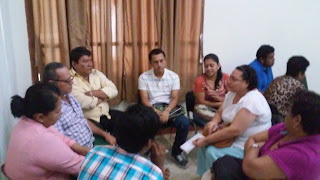Dairy and Discovery in Nicaragua
 |
| INDE workshop group in Managua |
Written by F2F Volunteer Michael Lofstrom
This assignment was carried out over a two week
period in Nicaragua essentially to assist five Nicaraguan entrepreneurs, small
businesses and small agricultural entities develop business plans for the
production and marketing of cheese, yogurt and other dairy products sold
locally. My business plan scope of work
was part of a team approach that paired me with Mike Doherty, an agricultural
economist with the Illinois Farm Bureau and who has many years of experience in
developing marketing plans for agricultural cooperatives and farmers in
general. Mike and I participated jointly
in all of the interviews with the entrepreneurs and enterprises, and we both
helped design and carry out on behalf of INDE three, half-day workshops for
small entrepreneurs in the cities of Managua, Chinandega and Masaya. During the course of our work there was a
certain amount of overlap and collaboration between the business and marketing
plans, with strategies and recommendations for adding product value, improving net
incomes, and in some cases new employment opportunities for the small farmer
populations in our designated areas.
 |
| Lofstrom with cheesemaker Milton Gonazalez and F2F field staff Moises Guillen |
At one of our interviews with entrepreneurs from the
dairy sector, one older gentleman asked me if I had been to Nicaragua
before. When I said yes, but 20 years
ago, he immediately replied “it’s a completely different country now” (“es un
pais completamente diferente, ahora es otro pais”). That was my distinct impression as well. A new generation of Nicaraguans are now
adults, and since Nicas tend to marry and have children early, a significant
percentage of the population is under 25 and has no direct connection with the
war years of the 80s and political struggles in the 90s. There appeared to be a strong preference,
especially with younger people, for entrepreneurial investments in areas of
economic advantage to Nicaragua as a whole – cattle and beef production and
exports; dairy products including cheeses and yogurts; environmentally
protected areas with tourism development; and shoe and leather goods
manufacturing among many other potentially strong economic sectors. Although yearly inflation based on planned
devaluations of the Córdoba tends to offset annual GDP growth of 5%, there is a
sense that Nicaragua will continue to progress in both economic and social
arenas and provide for a stable private sector for future growth and
development.

.png)

Comments
Post a Comment